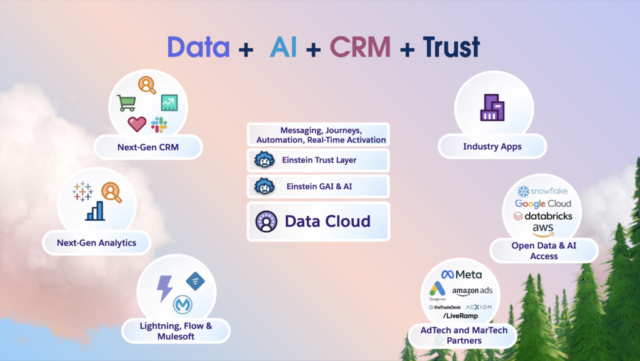Salesforce Data Cloud
Salesforce Data Cloud allows you to unify all your data on Salesforce without building complex data pipelines. Data Cloud easily takes action on all your data across every Salesforce cloud and enables trusted AI solutions powered by your data.

Data Cloud collect all your data from different sources and work together for you customer. Salesforce Data cloud is embedded with the Einstein 1 platform, which means any external database or warehouse can now drive actions and workflows inside of your CRM. Data Cloud is not only to collect data from different source applications. It’s about collecting different applications together to provide the customer with improved experiences and drive growth.
Data Cloud History
Salesforce Data Cloud started in 2020 as a Salesforce customer 360 audience. After that, it went through various stages of innovation, and in 2021, it was named Salesforce customer data platform. After that, it was known as a marketing cloud customer data platform and Salesforce Genie in 2022. Finally, in 2023, it officially became “Salesforce Data Cloud.”
Advantages of Salesforce Data Cloud
Data Cloud has multiple advantages, such as generating insightful decisions and unlocking actionable insights. Some of the benefits of Salesforce Data Cloud are shown below:
- Salesforce Data Enrichment: By using Salesforce Data Cloud, businesses can get their existing data in an updated, accurate, and more comprehensive format that can be useful for making business decisions.
- Third-Party Data Integration: Salesforce Data Cloud seamlessly partners with a wide range of third-party data providers, which means businesses can use industry-specific data sets, market information, and other external data sources.
- Data Security: Robust security mechanisms and encryption are used in Data Cloud to protect shared and stored data.
- Customer Targeting: Salesforce Data Cloud provides meaningful information to users, which helps businesses target the correct audience.
- Scalability: Salesforce Data Cloud can fit the needs of all sorts of businesses. It’s flexible enough to provide the right information to help a company grow.
Salesforce Data Cloud Architecture

Let’s understand the data cloud architecture in below:
-
Data Ingestion
- The Data Ingestion is to fetch/get data from an external system into the data cloud, called data ingestion.
- As shown in the above architecture image on the left side, these are all the data sources a business can have. It can be a Salesforce cloud (Sales, service, marketing, health, etc.) and other external platforms like Amazon S3, mobile and web connectors, Salesforce SDK, and more. Data cloud brings all these data source data together with less effort.
- Now, these data are coming in two formats: Batch & Streaming. Batch data is received periodically, like 1 hour, six hours, or daily. Streaming data is in real time.
-
Transform & Govern
- The next step in transforming your data is assembling it into a structured format using a data cloud. Using a data cloud, you can prepare, filter, and transform data before using it.
-
Harmonizing the data
- Data modeling or harmonizing is the process of transforming different data sources into a single standardized data model.
- In the Harmonisation stage of the data cloud, it will get all random unstructured data and convert it into a standard format.
-
Unify
- Unification in Data Cloud is the process of combining data from multiple sources into a single profile. It is based on user-defined identity resolution rules in a ruleset, data mappings, and match and reconciliation rules.
-
Insight & AI Prediction
- The insight is a statistically significant finding in your data.
- We can collect all data related to specific individuals in the Data Cloud. This means we can retrieve the targeted audience record for marketing, enhance our analytics, and improve our generative AI.
- In this phase, the data cloud helps us get calculated insight to analyze.
-
Segment & analyze your data
- Segmentation is a tool that lets users create targeted audiences for marketing campaigns.
-
Activation
- In the final stage, the Data Cloud activates the collected, analyzed, and processed data and generates insights. Now, in this phase, you can take appropriate action on processed data.
- At this stage, the processed data can be used for marketing purposes or to fulfill any other data-based business need.
Must Know Data Cloud Terms
- Data Stream: To fetch data from an external system into the data cloud, we need to create a data stream using connectors that will refresh every other day or continuously as we define the frequency.
- Data Lake Object (DLO): The fetched data from the external system comes into the data lake object first after running the data stream.
- Data Model Object (DMO): The data model object/harmonization transforms different data sources into a single standardized data model.
- Unified Profile: It will give a complete overview of collected information about the user.
- Identity Resolution: Identity Resolution in the data cloud is a data management process that combines data from different sources into unified profiles of customers and accounts.
Summary
In this blog, we covered the introduction of Data Cloud and its history, Data Cloud architecture, and how to understand how it works. We also discussed some of the critical terminology or key terms we should know when working on Data Cloud.


